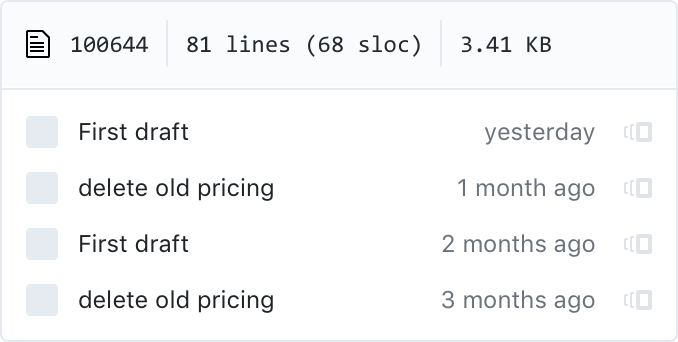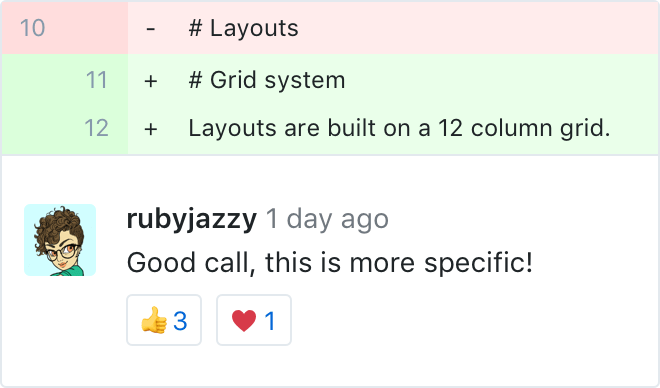
Write better code
On GitHub, lightweight code review tools are built into every pull request. Your team can create review processes that improve the quality of your code and fit neatly into your workflow.
Start with a pull request
Pull requests are fundamental to how teams review and improve code on GitHub. Evolve projects, propose new features, and discuss implementation details before changing your source code.
Make a change
Start a new feature or propose a change to existing code with a pull request—a base for your team to coordinate details and refine your changes.
Learn pull request fundementals

See every update

Diffs
Preview changes in context with your code to see what is being proposed. Side-by-side Diffs highlight added, edited, and deleted code right next to the original file, so you can easily spot changes.

History
Browse commits, comments, and references related to your pull request in a timeline-style interface. Your pull request will also highlight what’s changed since you last checked.
Pro-tip: You can search your commit history by keyword, committer, organization, and more.

Blame
See what a file looked like before a particular change. With blame view, you can see how any portion of your file has evolved over time without viewing the file’s full history.
Pro-tip: Use git blame to trace the changes in a file.
Discuss code

Comments
On GitHub, conversations happen alongside your code. Leave detailed comments on code syntax and ask questions about structure inline.

Review requests
If you’re on the other side of the code, requesting peer reviews is easy. Add users to your pull request, and they’ll receive a notification letting them know you need their feedback.

Reviews
Save your teammates a few notifications. Bundle your comments into one cohesive review, then specify whether comments are required changes or just suggestions.
Resolve simple conflicts
You can’t always avoid conflict. Merge pull requests faster by resolving simple merge conflicts on GitHub—no command line necessary.

Learn how to resolve merge conflicts on GitHub and using the command line.
Merge the highest quality code
Reviews can improve your code, but mistakes happen. Limit human error and ensure only high quality code gets merged with detailed permissions and status checks.
Permissions
Give collaborators as much access as they need through your repository settings. You can extend access to a few teams and select which ones can read or write to your files. The options you have for permissions depend on your plan.
Protected branches
Protected Branches help you maintain the integrity of your code. Limit who can push to a branch, and disable force pushes to specific branches. Then scale your policies with the Protected Branches API.
Required status checks
Create required status checks to add an extra layer of error prevention on branches. Use the Status API to enforce checks and disable the merge button until they pass. To err is human; to automate, divine!
Bulletproof your review process
Build on GitHub with review tools to avoid human error and add extra polish to your team’s code with review tools.

Codecov
Group, merge, archive and compare coverage reports

Codacy
Automated code reviews to help developers ship better software, faster

Coveralls
Ensure that new code is fully covered, and see coverage trends emerge

CodeFactor
Automated Code Review for GitHub
Get started
Most popular
Free
The basics for individuals
and organizations
Get in touch
Please contact us for more information$ 0 per month
Most popular
Team
Advanced collaboration for
individuals and organizations
Get in touch
Please contact us for more information$ 4 per user/month
Billed yearly at $48 per user/year
Most popular
Enterprise
Security, compliance,
and flexible deployment
Get in touch
Please contact us for more information$ 21 per user/month
Billed yearly at $252 per user/year